Historical Background
1953-1958: Development Phase (F3H to AH-1 and F4H)
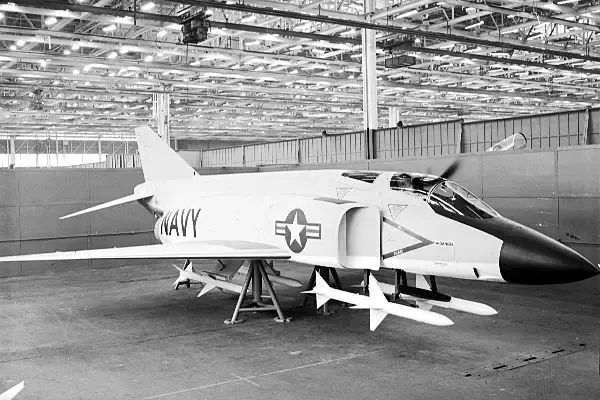 Mockup of the F-4 with AIM-7 Missiles
Mockup of the F-4 with AIM-7 Missiles
The developmental onset of the F-4 Phantom II began in the aftermath of McDonnell's loss in the US Navy's 1953 Day Fighter Competition - the victor of which was the Vought F8U. Choosing not to rest on failure, McDonnell representatives canvased the Navy Bureau of Aeronautics, a number of operational commands, the office of the Chief of Naval Operations, and any pilot or maintainer willing to discuss the state of current naval aviation.
After nearly a year of analysis and design work - including a full-scale mockup, the design of what they would classify as a general fighter took shape. The potential of a general fighter aircraft, rather than the specialized focus preferred by the Navy at the time, was rooted in the success of the F3H-1 Demon in the threading of that very needle.
F3H-1 Demon
The Demon had been built as a design in opposition to the F4D Skyray in the interceptor role. As the Skyray proved its supersonic superiority during the development cycle, McDonnell expanded the F3H Demon's capabilities to include respectable air-to-ground armament to justify its place in the limited carrier compliment when compared to the F10F Jaguar and F7U Cutlass, which were also undergoing development at the time.
Ultimately outfitted with the AIM-9 Sidewinder and AIM-7 Sparrow - the latter giving the F3H a beyond visual range capability that the Skyray could never boast, and topping out with the ability to carry and deliver 6,000 lbs of air to ground ordnance, the Demon out-measured its competitors in combat potential, even when it came in second on paper for raw performance.
Beginning with the intention to grow out the Demon as the baseline airframe, a set of engineering evaluations was performed, including both single and twin engine configurations with different wings. The two most promising data sets- twin-engine builds of the type, designated the F3H-G and F3H-H, and powered by the General Electric J65 and J79 respectively, replaced the original Demon wing with a 45-degree swept wing.
Particular focus was paid towards making the new aircraft multi-mission capable, running a wide gamut of potential operations: day or all-weather attack, photo recon, day or all-weather interception with a Sparrow-compatible radar, electronic warfare, and a two-seat strike coordination configuration. Experimentation with this wide-ranging design intent went so far as to include a novel interchangeable nose and cockpit arrangement, allowing airframes to be reconfigured within a matter of hours for a given mission set with the necessary systems fit for the crew.
While the Navy showed little interest in the nose replacement capability, the bottom line numbers from the F3H-G and -H investigations got their attention. On paper, they were capable of reaching Mach 1.52, and an eye-watering Mach 1.97 at 35,000 feet, respectively.
By October of 1954, the Navy Bureau of Aeronautics (BuAer) had evaluated similar unsolicited proposals from Grumman, Douglas, and North American, and provided McDonnell with a $38 million contract for two flying examples of the Demon follow-on - internally designated as the AH-1.
 McDonnell F3H-G mockup; US Navy photo
McDonnell F3H-G mockup; US Navy photo
AH-1
Two months later, the Navy threw McDonnell a curveball, directing the type to be stripped of the air to ground fitment, and focusing on the all-weather interceptor role in a single-seat configuration, with the finalization for this change in role being formally announced in April of 1955.
The changeover was, in some quarters, considered catastrophic - over time forcing the removal of the planned internal gun, and stripping all of the hard-points, save for the recessed Sparrow fuselage wells and a centerline tank position. At this point, the determination of the J79 as the power plant was finalized with the Navy's desire for a Mach 2 interceptor. Further, the determination of a two-man crew, as also put in place by the Navy, like McDonnell's own research, success in the faster, longer-range interception environment showed the utility of a second man to handle the scope.
However, it wasn't a done deal. BuAero had been keeping conversation with Vought at the same time, and in mid-1955, detailed a fly-off between the two competing firms for the new interceptor role; this time pitting McDonnell's AH-1 contender with an outgrowth of the already in-service Crusader: the F8U-3.
F4H (F-4A)
Redesignated the F4H (or also F-4A) in the intervening two and a half years leading into the late 1958 fly-off, McDonnell's Phantom II would trade substantial blows with Vought's Crusader III during the Navy Preliminary Evaluation. Whereas McDonnell's design entered the flight testing phase a month prior (and nominally entered engineering almost a year ahead of Vought's entry), the benefits of Vought carrying over much of the prior Crusader's aerodynamic profile appeared early in the comparison. The Crusader III was the first to reach Mach 2 in flight testing, shown capable of reaching higher top speeds during the Navy preliminary evaluation, and noted for having a more refined airframe handling in most regimes.
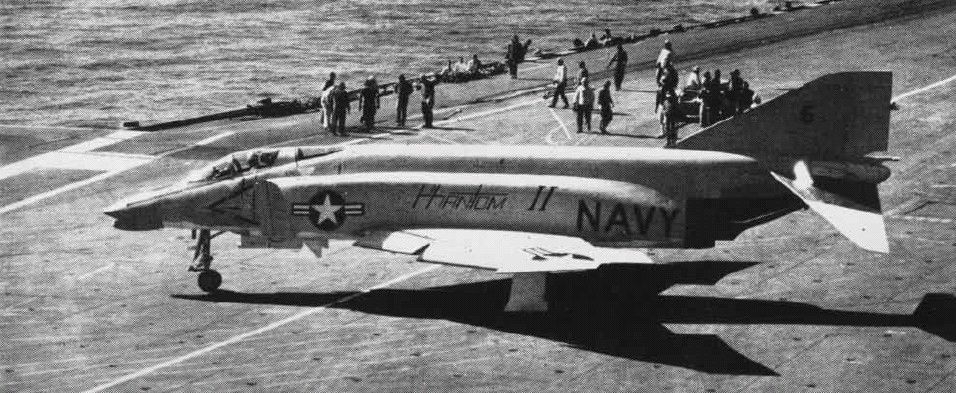 F-4H aboard the USS Independence in 1960; US Navy photo
F-4H aboard the USS Independence in 1960; US Navy photo
But as the Evaluation continued, it was found that McDonnell's Phantom II countered the Crusader III where it mattered: in combat capability. The Navy wanted a Mach 2 interceptor, not an overgrown daylight fighter.
The F8U-3's integration of the Sparrow was found lacking versus that of the Phantom, having surrendered an AIM-7 against the F4H due to aerodynamic performance concerns. Of even greater concern for the interceptor role, as McDonnell had previously found internally, the pilot overhead to manage the AN/APG-74 radar installation in the Crusader III while in combat, was found to be too high to maintain effectiveness, whereas the back-seater in the Phantom II could reliably acquire situational awareness on the radar and maintain track locks for engagement while maneuvering.
McDonnell's F4H, while having more raw flying qualities, could fight as the Navy needed it to. Further, as the firm had continued developing its air-to-ground potential at the request of the Navy, even as they repeatedly altered the program goals - the Phantom II, like the Demon before it, justified its existence in the carrier complement in all fights, not just the long-range interception role. And so on December 17th, 1958, the Navy Preliminary Evaluation board announced its findings and the winner of the fly-off: McDonnell's Phantom II.
1958-1963: A Navy Interceptor with Multi-role Pedigree (F4H to F-110 and F-4)
The US Air Force was not oblivious to the Phantom II's development, as the Navy having asked for the air-to-ground capability to be revisited, gave McDonnell a point of entry. While the Air Force entertained McDonnell representatives in discussion about a new ground attack airframe, the service actually had interest in the Sparrow-dealing F4H as a replacement for the F-106.
The Air Defense Command requested an evaluation in 1961 known as Project High Speed, which once again proved the Phantom II superior to a challenger in the interceptor role. In light of the findings, Navy offered a bombing demonstration for Air Force representatives of the Tactical Air Command, making special note of the successful air-to-ground trials with the Phantom's multiple ejector racks - a capability the USAF lacked. With Air Force policymakers, members of Congress, and even General Curtis LeMay in attendance during this demonstration series - with a VX-5 F4H-1 accurately delivering twenty-two 500 lb bombs in spectacular fashion, the stage was set for a Navy/McDonnell tactical aviation coup.
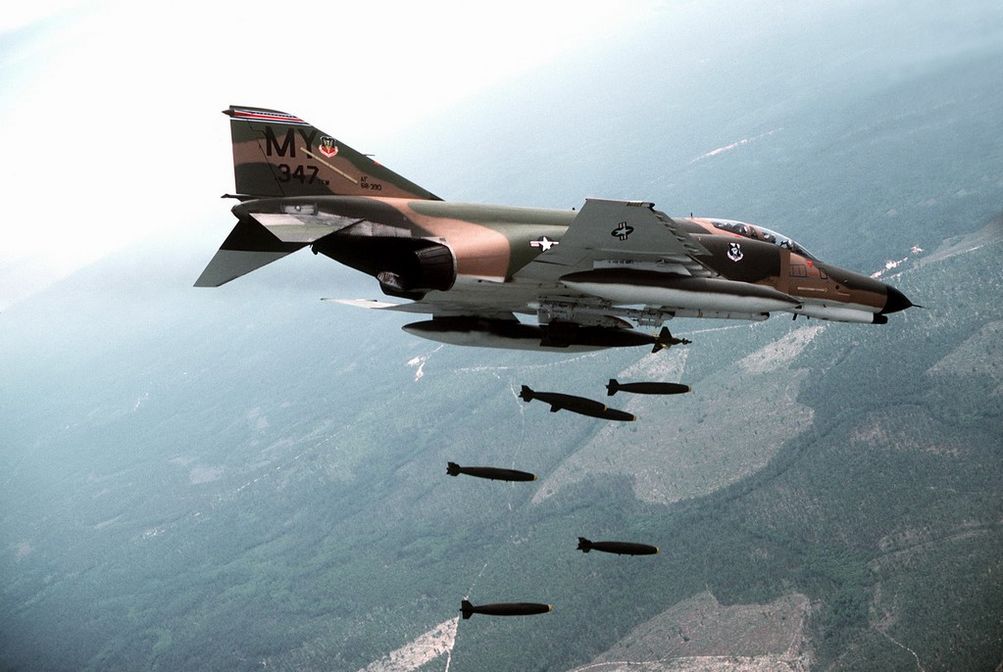 F-4E Phantom II of the 347th Tactical Fighter Wing airdropping six 500-lb Mark 82s
F-4E Phantom II of the 347th Tactical Fighter Wing airdropping six 500-lb Mark 82s
The inauguration of the Kennedy administration in January 1961 didn't hurt matters; Kennedy brought in former Ford Motor Company president Robert McNamara as Secretary of Defense. With an eye for optimization - sometimes to a fault, the performance of McDonnell's F4H was seen as a standout to capitalize upon in light of the administration's new conventional doctrine of "Flexible Response"; no longer would nuclear deterrence be the primary backstop of the US' promise to NATO.
While McNamara desired for the Navy's A-7 and the Air Force's F-111 to fulfil tactical bombing roles for both services, the two airframes were at least five years out to operational capability; the Phantom existed, provided outstanding performance immediately, and could quickly raise the desired 50% increase in conventional force structure the White House expected for the Air Force. Pressure from all sides - the White House, Congress, McDonnell, and foreign interest, ultimately defeated the USAF's resistance to an airframe "not made here", and by January 1962 the USAF's budget had Phantoms on order from the Tactical Air Command; the Air Defense Command, which had started the Air Force's investigation into the Phantom, would be left with the F-106.
F-110 Spectre
Designated for a time as the F-110 to fit in with the Air Force's Century Series as a matter of service pride, McDonnell's Air Force Phantom went into motion. An initial delivery of Navy-configured F4Hs was provided for training and evaluation later that year, with the first flight of a true F-4C taking place on May 27th, 1963 - the universal service designation system converting the F4H-1 to the F-4B in September of 1962.
F-4B and -C
Reconfiguration of the Phantom II for the USAF was expedient, with the focus being on service-compliant alterations. These included altering the landing gear system for higher speed field operations, the addition of dual flight controls, an anti-skid implementation, and conversion to boom refuelling compatibility.
Further changes included the addition of the LN-12 inertial navigation system, conversion to the APQ-100 radar with air-to-ground specific functionality, and a cartridge starting system for field use without a compressed air cart in combination with an internal battery.
This F-4C configuration would be the first Phantom used during the USAF's involvement in Vietnam, beginning in December of 1964.
1965-1974: Backtracking with Haste - Vietnam (F-4D and F-4E)
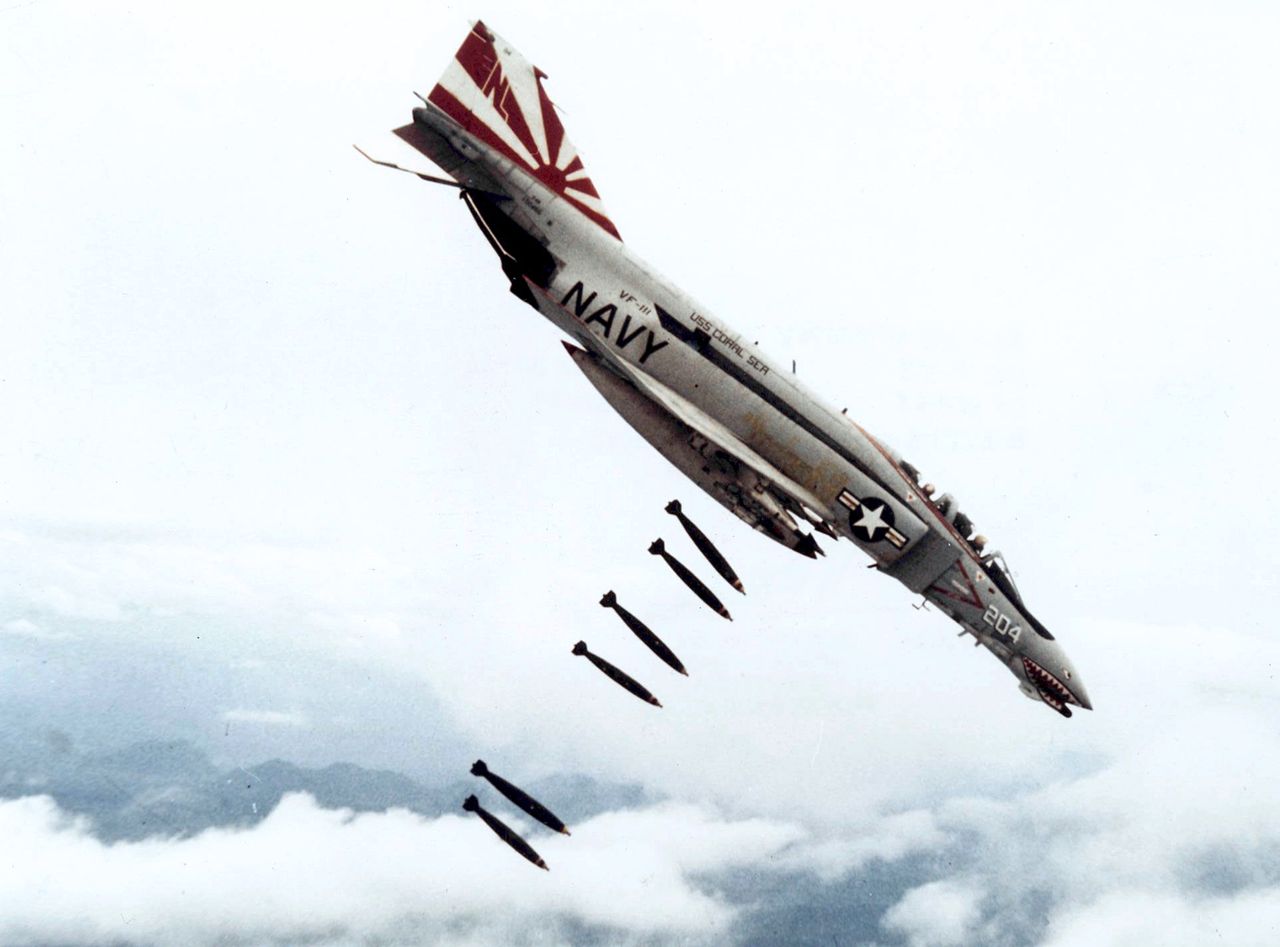 F-4B dropping bombs over Vietnam; US Navy Photo
F-4B dropping bombs over Vietnam; US Navy Photo
The Phantom's initial deployments to Southeast Asia delivered a number of firsts - the first officially confirmed MiG-17 kill with the AIM-9 Sidewinder (on July 10th, 1965), and the first US air-to-air shootdown of a MiG-21 (April 26th, 1966). Unfortunately, the Phantom was also the victim of the first US loss to a SAM in Vietnam (July 24th, 1965), and the first US air-to-air loss from a MiG-21 (October 5th, 1966).
With the initial teething problems of the type out of the way, including alterations to the wing fuel cells and internal wiring, the Phantom was found to be a capable, reliable airframe for the Air Force. Even the missing gun had been worked around to some degree, with the integration of the SUU-16 and SUU-23 external cannon pods.
F-4D
The in-production upgrade to the Air Force's first Phantom - the F-4D, would include a multitude of quality of life improvements: the APQ-109 radar with air-to-ground modes, the ASN-63 internal navigation system, the ASQ-92 release computer, and the APX-80 "Combat Tree" IFF system. Further additions would include automatic fuel transfer and a new sight, the ASG-22. Combat survivability would be reinforced with the APS-107 RHAW and ECM pod compatibility, along with new ejection seats. Yet, the service's desire to put its own "made here" flourish on the type continued, inauspiciously culminating in the integration of the AIM-4 Falcon with the F-4D model.
AIM-9 vs AIM-4
Used on the F-102 Delta Dagger and F-106 Delta Dart, and considered by some to be a reasonable competitor to the AIM-9 Sidewinder, Air Force leadership believed the AIM-4 Falcon could be installed in place of the Navy's short-range round with no loss of capability; this was quickly found to be a mistaken premise.
While the AIM-9B had limited maneuvering restrictions for launch and acquisition like other short-range infrared missiles of its generation, it was substantially more reliable in use; the Falcon's cooling implementation could only maintain the required seeker temperature for a short time once activated, and could not be turned back on once the cooler timed out, while the uncooled 9B could remain available indefinitely.
Sidewinder acquired far more rapidly, in many instances, in less than two seconds, versus the six to seven seconds required for the Falcon.
Worse still, the AIM-4 was a hittile - its fin-contact triggered fuzing required direct target impact for the missile's warhead to detonate, whereas the AIM-9 carried a proximity fuze; any Sidewinder that got close to its target was a threat to kill.
 F-4D of the 435th TFS over Vietnam
F-4D of the 435th TFS over Vietnam
With initial F-4D deliveries to the 8th TFW in May of 1967, the performance of the new configuration was quickly met with derision. The employment envelope was too small compared to the Sidewinder, the lead time too long, and the weapon far too unreliable to put into practice in the dynamic maneuvering environment of air combat as it was waged in Southeast Asia.
The failure of the Falcon to succeed not only served to reaffirm the quality of the Sidewinder in comparison - and also highlighting the need for the service to upgrade the round as the Navy was doing, but reinforced the concern held by aircrews about the lack of an internal gun. SUU installations by this point had scored multiple victories over North Vietnamese MiGs (ultimately ending the war with 9 confirmed kills), and it was decided to rectify what many had considered the Phantom's original sin, with further revision to the F-4.
F-4E
By this time, McDonnell was laying down the program update plan for the F-4E, and the jet was intended to carry the M61A1 gun internally, and with it, the Hughes CORDS (Coherent On Receive Doppler System) radar. Hughes was unable to successfully deliver their CORDS system, and the Westinghouse APQ-120 radar would be selected in January 1968 as its replacement. The APQ-120 was a full solid-state conversion of the APQ-109/117, re-engineered to meet the requirements of the internal cannon installation. The radar would receive changes to its mount, additional dampening, and a reduction antenna's height to fit in the smaller cavity directly above the cannon barrel assembly.
Further adjustments to the F-4E were made to improve the Phantom's lethality. Hardware deleted for Sidewinder compatibility in the F-4D was updated and returned. The ASG-26A Lead Computing Optical Sighting System was installed along with updated aircrew in-range and shoot warning cues, providing pilots with a clearer picture of the weapons envelopes of the Sparrow and Sidewinder. The updates to the Echo Phantom would not stop there; compatibility with multi-ejection racks and updates to the Weapon Release Computer to match provided further bombing capabilities, the AGM-65 Maverick was made available in both IR and electro-optical variants, the leading edge of the wings were fitted with slats for increased maneuvering potential, and the Digital Scan Converter Group interface for the APQ-120 was installed.
Unfortunately, the F-4E's initial deliveries from October of 1967 would align its operational entry with the drawdown of the US' Rolling Thunder bombing campaign over North Vietnam. The type would have to wait until 1972 to put the true extent of the jet's upgrades to the test. With the resumption of the air campaign in February of that year, the E-model Phantom II would fly thousands of missions, and in the span of seventeen months, score 21 air-to-air kills.
Training Program Rivet Haste
Also of note was Rivet Haste - a late Vietnam training initiative in 1972 heavily influenced by two midlife updates - modification "556" and TISEO.
Prior to "556", weapons mode changes required the pilot to go hands off the throttle and look down to the release panel, cycling a number of switches to disarm various pylons and arm others; in the event of a lucky North Vietnamese bounce, or the need to swap between weapons on the fly, looking away from the threat was time-consuming and dangerous.
With the modification, a pair of override switches was added to the outboard throttle grip. The first, the "pinky" switch, placed control of the gun, Sidewinder, and Sparrow in one of three positions, while the second, on the forward face of the grip, switched weapons modes immediately between air-to-air and air-to-ground; the pilot would now have immediate access to his air-to-air weapons, and could swap them on the fly - never once looking down in the cockpit. This modification gave birth to the concept called HOTAS - hands-on throttle and stick.
556 also included modifications to the armament panel for air-to-ground munitions, adding ripple release capability while reducing the number of controls required to access full ARBCS programming.
TISEO Upgrade
Further reinforcement of crew initiative was the installation of TISEO - the Target Identification System Electro-Optical, in 1974.
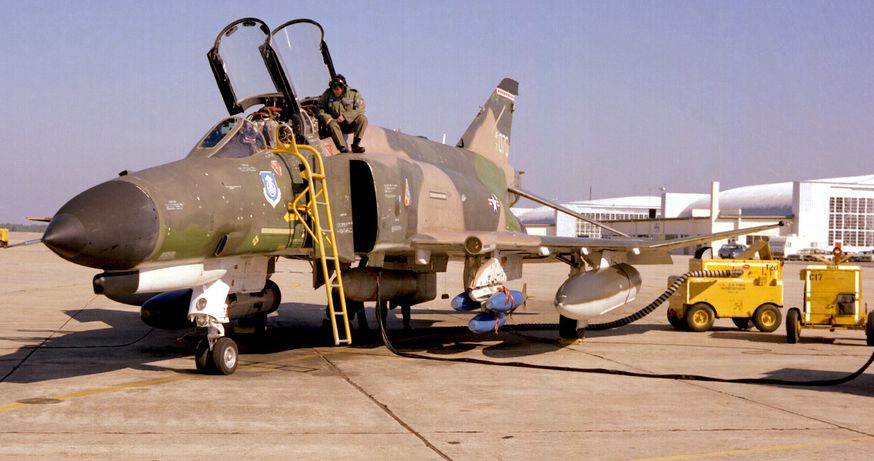 An F-4E Phantom II with a TISEO mounted on the left wing above the blue practice bombs
An F-4E Phantom II with a TISEO mounted on the left wing above the blue practice bombs
Consisting of a 4x/10x camera installed in the left wing, TISEO provided visual identification of distant, radar-locked targets, enabling the AIM-7 Sparrow to be used to its full extent when combined with the APX-80 IFF system. Crews could now independently confirm two ID factors before the merge, entering the fight with more of an advantage, even if they would not be cleared to fire beyond visual range.
Coupled with the Rivet Haste training, which put experienced aircrews through a program to codify them as systems and tactics instructors (not unlike the NFWS education being given to USN crews at the same time), the students championed the modification program of the Phantom, and pushed for Double Attack (a parallel development of Loose Deuce as had been used by the Navy in Vietnam since the resumption of the bombing campaign) to become the standard for air-to-air methodology across the Air Force.
While this training was ultimately too late to have a real effect, with the final halt on US bombing coming just weeks after the first Haste student crews returned to Vietnam, they would set the tone for USAF Phantom crews going forward.
1975-1991: A Cold Warrior
As the Vietnam War drew to a close, the F-4E transitioned from active combatant to a cold warrior. While the F-15 and F-16 both stood on the horizon to take the premiere positions in tactical air-to-air and air-to-ground roles, the sheer depth of the Phantom's numbers across the USAF and its allies meant the F-4E would remain at the tip of the spear for another two decades.
Keeping the F-4 effective as a strike platform and air-to-air combatant was vital, and the E's capabilities continued to be expanded into the 1980s. Provision for the all-aspect AIM-9L and M Sidewinders would be installed, as well as the improved AIM-7F, and later, the AIM-7M Sparrow. The television-guided GBU-15, with its required data-link system, would be integrated in the Phantom beginning in 1975. To deliver additional guided munitions, the F-4E would receive not one, but two targeting pod options - Pave Spike and Pave Tack.
Of particular note is the installation of the Digital Modular Avionics System, or DMAS. DMAS was a complete replacement of the Phantom's navigation computer, inertial navigation set, and the WRCS, which used LORAN (Long Range Navigation) radio signals to accurately define the aircraft's position anywhere in the world. The inclusion of DMAS provided a substantial improvement in the F-4E's navigation options and weapon release precision, and an expansion of the Phantom's delivery mode capabilities.
The F-4E would see its front-line service end in the United States Air Force immediately following Operation Desert Storm, with the last remaining users of the type withdrawn from active duty service. US Air National Guard units would maintain the type until the mid-90s, with various units seeing them replaced by other types as appropriate for their respective missions and locations.
The F-4E Phantom II Today
Of all Phantom models, the F-4E was the most numerous version that has been built totalling at 1370 units.
The F-4E Phantom II is still in service at some operators across NATO including the Hellenic Air Force, the South Korean Air Force and the Turkish Air Force.
They are expected to fly at least until 2030.
Variant Overview
Beyond the F-4E, several Phantom variants have been built for various purposes.
| Variant | Description | Base Variant | First Flight |
|---|---|---|---|
| A | Prototype and pre-production model | 1958 | |
| B | First production ready model for the US Navy | A | 1961 |
| C | Several improvements for more effective use by the USAF | B | 1963 |
| D | Modernization and improved air to ground capabilities | C | 1965 |
| E | Further improvements, better radar and nose gun | D | 1965 |
| F | Slimmed down export variation used by Germany | E | 1973 |
| G | Wild Weasel upgrade to locate and fight SAM systems | E | 1976 |
| J | US Navy variation for carrier operation | B | 1966 |
| K | Royal Navy variation with a different engine | J | 1966 |
| M | Royal Air Force variation with a different engine | J | 1966 |
| N | Modernized systems and structural improvements | B | 1970 |
| S | Modernized systems and smoke-free engines | J | 1977 |
| RF | Several Phantom variants modified for reconnaissance | B, C, E | |
| QF-4 | Retrofitted as remote-controlled target drones for research | many |